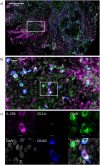Multiplex immunofluorescence assessment of macrophages and IL-23R in inflammatory and malignant diseases of the oral mucosa: a pilot study
- PMID: 40297579
- PMCID: PMC12034713
- DOI: 10.3389/fimmu.2025.1569490
Multiplex immunofluorescence assessment of macrophages and IL-23R in inflammatory and malignant diseases of the oral mucosa: a pilot study
Abstract
Background: Immune cells play a major role in the development and progression of inflammatory and malignant diseases of the oral mucosa. There is growing evidence that immune cells contribute to oral cancer progression and metastases. Inflammatory carcinogenesis is believed to be relevant for oral Lichen Planus as well as for oral Leukoplakia. In addition, there is growing evidence that periodontitis might also be linked to oral cancer development. Yet there is no analysis available comparing the immune cell composition in these different inflammatory and malignant neoplastic diseases. A better understanding of similarities and differences of the diseases could eventually also pave the way for the use of immunotherapy in non-malignant diseases.
Methods: In the current pilot study, a tissue microarray (TMA) was created of a total of 29 patients with periodontitis (PD, n=4), oral Leukoplakia (OL, n=4), oral Lichen Planus (OLP, n=4), oral squamous cell cancer without lymphatic metastases (OSCC N0, n=5), or with lymphatic metastases (OSCC N+, n=4), OSCC biopsies prior to and resection specimens after anti-PD1 immunotherapy (IT) (each n=3) as well as healthy control gingiva (n=5). In each patient two tissue samples were analyzed. The TMA was stained with a 4X multiplex immunofluorescent staining for IL-23R, CD68, CD11c, and CD163. Samples were digitalized and an AI-based cell counting was performed. Statistical analysis was performed using the Mann-Whitney U test.
Results: IL-23R expression, macrophage infiltration as well as M2 polarization in OL and OLP were significantly higher compared to controls. OLP showed a significantly higher M2 infiltration and polarization than OL. PD showed a trend for increased macrophage infiltration compared to controls without significance. N+ OSCC showed a significantly increased macrophage infiltration compared to N0 cases. In response to anti-PD1 IT, CD11c and CD163 infiltration was significantly increased. Most IL-23R positive cells co-expressed macrophage markers.
Conclusion: A TMA in combination with 4-plex immunofluorescence is suitable for immune cell characterization in different oral diseases. Macrophage infiltration and polarization in precursor lesions seems to be associated with OSCC development as well as metastatic spread. IL-23 pathway inhibition might be a potential target for oral Lichen and Leukoplakia.
Keywords: Lichen Planus; N+; OSCC; leukoplakia; lymph node metastases; oral cancer; oral medicine; periodontitis.
Copyright © 2025 Trumet, Grötsch, Agaimy, Galler, Geppert, Winter, Ries, Kesting and Weber.
Conflict of interest statement
The authors declare that the research was conducted in the absence of any commercial or financial relationships that could be construed as a potential conflict of interest. The author(s) declared that they were an editorial board member of Frontiers, at the time of submission. This had no impact on the peer review process and the final decision.
Figures







Similar articles
-
Malignant transformation of oral leukoplakia is associated with macrophage polarization.J Transl Med. 2020 Jan 7;18(1):11. doi: 10.1186/s12967-019-02191-0. J Transl Med. 2020. PMID: 31910881 Free PMC article.
-
CD133 expression in oral lichen planus correlated with the risk for progression to oral squamous cell carcinoma.Ann Diagn Pathol. 2013 Dec;17(6):486-9. doi: 10.1016/j.anndiagpath.2013.06.004. Epub 2013 Aug 2. Ann Diagn Pathol. 2013. PMID: 23911820
-
[Determination of human papillomavirus in oral leukoplakia,oral lichen planus and oral squamous cell carcinoma].Beijing Da Xue Xue Bao Yi Xue Ban. 2016 Feb 18;48(1):84-8. Beijing Da Xue Xue Bao Yi Xue Ban. 2016. PMID: 26885914 Chinese.
-
Cytokine profiles contribute to understanding the pathogenic difference between Good syndrome and oral lichen planus: two case reports and literature review.Medicine (Baltimore). 2015 Apr;94(14):e704. doi: 10.1097/MD.0000000000000704. Medicine (Baltimore). 2015. PMID: 25860215 Free PMC article. Review.
-
Evaluation of Potential Risk Factors that contribute to Malignant Transformation of Oral Lichen Planus: A Literature Review.J Contemp Dent Pract. 2016 Aug 1;17(8):692-701. doi: 10.5005/jp-journals-10024-1914. J Contemp Dent Pract. 2016. PMID: 27659090 Review.
References
MeSH terms
Substances
LinkOut - more resources
Full Text Sources
Medical
Research Materials

